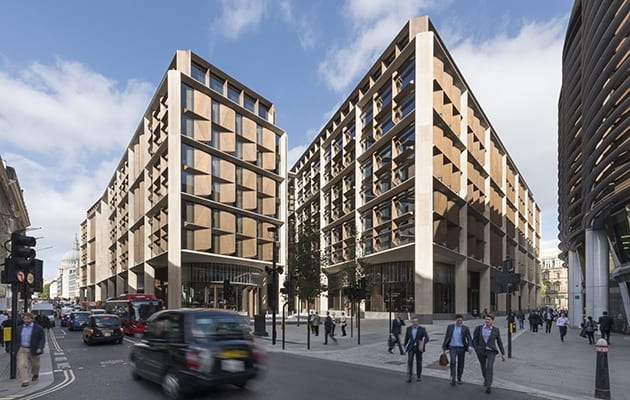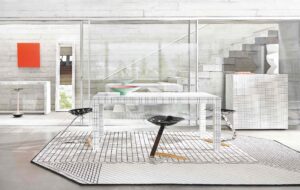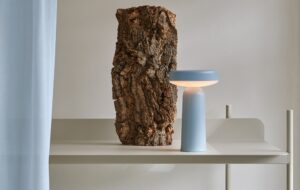 The new Bloomberg HQ in the City of London|||
The new Bloomberg HQ in the City of London|||
The microscooter has hopefully been consigned to history, but other signs of the tech and creative industries are flourishing, this time in London’s Square Mile, as the City of London is evolving. At Bank junction, One Poultry – a bit of a Marmite building – is being revamped with WeWork on board as a tenant, while the nearby Ned has brought people queuing to get into the former Midland bank building, and the new Bloomberg building has provided a talking point in office interiors.
Change can be seen elsewhere such as British Land’s extensive work at Broadgate. Could it be that the City of London has – whisper it – become a cool place to spend one’s working day, and beyond? Jacob Loftus, CEO of developer General Projects, describes the James-Stirling-designed One Poultry, completed in 1997, as “the naughty schoolboy of Bank station. Around there, there is the most prominent British architecture of the last few hundred years and then there’s this postmodernist building cheekily winking at you.”
‘The first really creative building in the City’
Along with architect BuckleyGrayYeoman (BGY), which was appointed by Aermont in 2014 for a refurbishment that escalated into creating a whole new vision for the building, Loftus is part of the team aiming to make this “misunderstood piece of architecture” into “the first really creative building in the City”.
 The new Bloomberg building across the street from One Poultry
The new Bloomberg building across the street from One Poultry
One Poultry’s most recent chapter involves a sensitive transformation with contemporary design impetus courtesy of the London-based practice. As BGY’s Matt Yeoman points out, this has been subtle but comprehensive: “From the street, you might not notice the change, but in terms of experience we’ve brought the building right up to contemporary standards.”
A hardhat tour courtesy of contractor Paragon gives a peek into what’s being done structurally, from four new lift shafts to new windows in the central drum – added on the first floor and extended on the second to let in more light. The grand staircase will be reopened, while the reception has been moved to a double-height retail unit with new glass frontage and an entrance to Queen Victoria Street, facing the Bloomberg HQ.
‘Materials that match the standard of the original building’
“Everything has been completed with high-quality materials that match the standard of the original building,” says Yeoman. Any structural element that requires more of the building’s signature buff-coloured stone has had to be carefully managed, as that particular hue is in short supply. A new arch – part of the new 370sq m reception – to be constructed at the apex end of a ramped walkway, will match that at the other end, in the centre of the building.
 One Poultry has just gained Grade II* listed status
One Poultry has just gained Grade II* listed status
“We are cultural custodians of a building of major significance,” Loftus says, adding that the building gaining Grade II* listed status just four weeks after work had begun to strip it out was a very big challenge. One Poultry in its 2.0 iteration then, offers 10,200sq m of office space as well as space for cyclists on the basement mezzanine level (services are on the very bottom basement level) plus a Puttshack mini golf course on the concourse level, and some “non-City” food and beverage operators.
Enviable city-wide views
This F&B offer leads us neatly on to The Ned, operated by Soho House and the Sydell Group. It was the subject of the kind of breathless anticipation usually reserved for a Shoreditch popup before it opened late last spring. Named after its designer, Sir Edwin “Ned” Lutyens, it includes ten restaurants and a 250-room hotel, taking design cues from the 1920s and 1930s, with brass and mahogany furniture, chandeliers and maximalist surface patterns completing this particular look.
Ned’s Club Upstairs features a heated pool and two outdoor terraces with enviable City-wide views, while Ned’s Downstairs has a late-night lounge bar in the original bank vault plus the Long Bar, a lounge, the Dining Room restaurant and a trio of booths called The Kennels, the Snug and the Sitting Room. While these elements, plus a barbers, a hair salon, another pool, a hammam and fitness studio are for members only, the general public has the choice of several drinking and dining options in the former banking hall on the ground floor.
 The exterior of The Ned in the City of London
The exterior of The Ned in the City of London
Heading out onto another axis of Bank station, one of the strongest ideas that came out of Bloomberg’s new HQ, was for its 4,000 employees to “get out and enjoy the local economy.” As Michael Bloomberg boldly told the Evening Standard: “We are going in the opposite direction to Google – we encourage people to go outside.” Bloomberg’s 1.3ha site features two buildings, north and south; in between is a new civic space, Bloomberg Arcade, which will be home to ten independent restaurants.
Though this is a new building, by Foster + Partners, there are references to the area’s past. The facades have a stone frame, the biggest stone project in the City for a century. This is inset with bronze ns which shade the floor-to-ceiling glazing. The entrance is slightly disorientating, and deliberately so.
No future is possible without a past
People are drawn into “The Vortex” a dramatic, double-height space created by three curving timber shells. Look up as you walk through and you’ll see an Olafur Eliasson artwork, No future is possible without a past, in all its reflected glory. Guests are ushered into the lifts which, engineering buffs will note, have a lifting motion from underneath rather than pulling from the top.
 The internal ‘vortex’ at Bloomberg
The internal ‘vortex’ at Bloomberg
Either way, a quick whoosh and you’re landed on the sixth floor. Here you can see some of the structural elements that really make this place stand out. The integrated ceiling is described as a series of aluminium “petals” but is in reality far more masculine. These aren’t just for show but work hard in terms of cooling and acoustics – an all-in-one energy-efficient system.
The atrium roof-light provides natural light deep inside the building. Then there is the monumental swirling staircase. As on the outside, bronze dominates. None of the functions the staircase performs– a visual link to the floors and corresponding wayfinding, a place for those much-talked-about chance encounters and of course, a way to get from a to b – are new, but it’s a big, brute of an example and again another melding of engineering and architecture.
99% SMEs bringing new ways of working
The core of the building is pushed to the perimeter and by spacing the columns on a triangular grid, the open-plan layout is truly… open. Everyone has a sit-stand desk, though in these relatively early days this hasn’t quite caught on. What’s clever about the workstations is the cluster arrangement with a central table for informal meetings and pedestals that are padded so you can pull up a seat.
Chris Hayward, chairman of the Planning and Transportation Committee at the City of London Corporation, cites Bloomberg as one example of the changing occupancy of the City of London – as well as shaking up the provision of public space for the better. As 99% of businesses in the Square Mile are now SMEs, stakeholders have to embrace the new ways of working this demographic brings.
 One of two roof terraces in The Ned overlooking the City
One of two roof terraces in The Ned overlooking the City
“We particularly encourage developers to offer much more flexible workspace. The days when one company occupies a tower are no more,” he says. “High-quality public realm is as important as the buildings themselves,” says Hayward, adding that the corporation has invested in high-capacity public wi- and broadband, with cyber security high on its agenda.
’24/7 City for both work and play’
Air quality is a priority, so much so that only buses, cyclists, and pedestrians are allowed around Bank station from 7am-7pm. One other thing Hayward is passionate about is the provision for the arts and the recent launch of the Culture Mile, an arts cafe.
By 2019, Broadgate’s retail and leisure offer will have doubled in size. Nearby, architect Orms received planning last year to enliven 3 Broadgate, transforming an important public link between two bustling public squares: Broadgate Circle and Finsbury Avenue Square.
It will retain the cylindrical form of the building by Arup Associates, re-clad the facade and create a larger arched opening. And as the City develops its creative side, this has encouraged the likes of Deliveroo to locate in the Square Mile rather than further out of town or in trendy Shoreditch. The fact that there are more cranes in the City now than in the 1980s boomtime says a lot.
As Hayward says: “It’s rapidly becoming a 24/7 City for both work and play.”
Subscribe to OnOffice for more like this
With WeWork moving into a newly updated One Poultry, Bloomberg in a Foster landmark, and day-to-night venues like The Ned, London’s Square Mile is fast becoming a centre for creative life and style–both at work and after




















